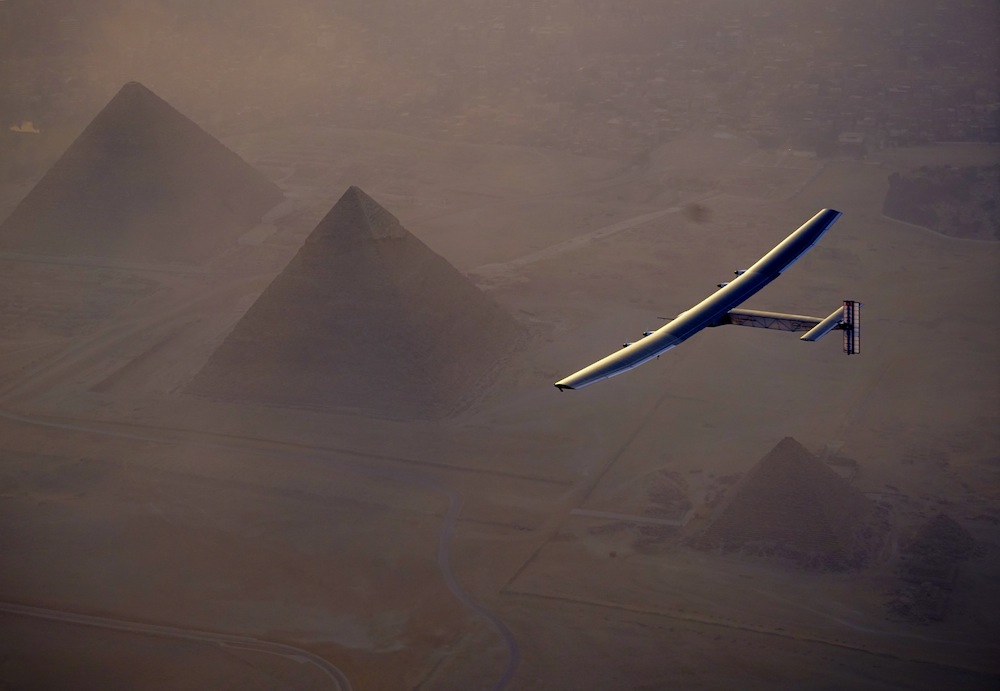Solar Plane Zooms Over Egypt's Pyramids on Historic Flight

A solar-powered airplane buzzed the pyramids in Egypt, flying over the iconic, haze-cloaked monuments, during the most recent leg of its historic journey around the world.
The aircraft, known as Solar Impulse 2, landed in Egypt on July 13, after flying nonstop for nearly 49 hours from Spain. It was the second-to-last leg of the plane's ambitious round-the-world flight to promote renewable energy sources and spur the development of "green" technologies.
The dramatic photos of Solar Impulse 2 soaring over the pyramids offer a striking contrast between ancient and futuristic technology, with the solar-powered aircraft representing a way that some machines, including airplanes, could be powered one day. [See more photos of the plane's round-the-world flight]
"This was an emotional and meaningful leg for me, being able to enjoy once more the incredible sensation of flying day and night thanks only to the energy of the sun and enjoying fully the present moment," pilot André Borschberg, Solar Impulse's co-founder and CEO, who flew the plane from Spain to Egypt, said in a statement.
Solar Impulse 2 is designed to fly day and night without using any fuel. The single-seater plane is powered entirely by 17,000 solar cells and onboard batteries, which charge during the day to enable the plane to fly continuously through the night and during cloudy weather.
The ultralightweight plane weighs only 5,070 pounds (2,300 kilograms), roughly equivalent to a car, but has an impressive wingspan that stretches 236 feet (72 meters), according to company officials.
Borschberg and his fellow co-founder, Bertrand Piccard, have been alternating being at the controls of the solar plane for each leg of the round-the-world journey. Piccard is expected to fly Solar Impulse 2 on the last leg of the expedition, from Egypt to Abu Dhabi, in the United Arab Emirates.
Get the world’s most fascinating discoveries delivered straight to your inbox.
"This landing in Cairo brings Solar Impulse back to the origin of my dream," Piccard said in a statement. "Egypt is the country where I landed after my non-stop round the world balloon flight in 1999, and it's precisely here that I had the idea of an airplane flying around the world on solar power."
Solar Impulse 2 embarked on its journey around the world in March 2015, taking off from Abu Dhabi's Al Bateen Executive Airport on a flight to Oman. The plane next made stops in India, Myanmar, China and Japan before completing a record-breaking flight across the Pacific Ocean to Hawaii, in the United States, in July 2015. The plane was then grounded in Hawaii for almost a year because overheated batteries had caused irreversible damage to the plane.
The aircraft resumed its journey earlier this year, in April, flying from Hawaii to California. It then crossed the U.S., making stops in Arizona, Oklahoma, Ohio, Pennsylvania and New York. The plane became the first solar-powered aircraft to cross the Atlantic Ocean, after it flew from New York to Spain in 71 hours and 8 minutes. If the next and final leg of the expedition is successful, Solar Impulse 2 will become the first solar-powered plane to circumnavigate the globe.
In 2013, Borschberg and Piccard completed an unprecedented coast-to-coast flight across the United States, using a first-generation prototype of the Solar Impulse plane. That two-month journey included five stops between California and New York.
Original article on Live Science.

Denise Chow was the assistant managing editor at Live Science before moving to NBC News as a science reporter, where she focuses on general science and climate change. Before joining the Live Science team in 2013, she spent two years as a staff writer for Space.com, writing about rocket launches and covering NASA's final three space shuttle missions. A Canadian transplant, Denise has a bachelor's degree from the University of Toronto, and a master's degree in journalism from New York University.


